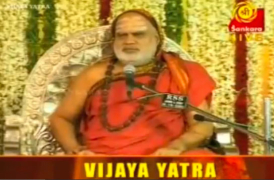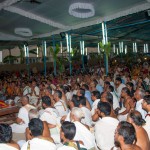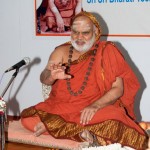
Coimbatore: MARCH 20 – APRIL 1, 2012
Arrival
The Jagadguru reached Coimbatore on the evening of 20th March and was received with great devotion by a huge number of devotees. Dhuli Pada Puja to the Jagadguru was performed by Dharmadhikari Sri C G Venkataramanan at Sharadalayam, Sringeri Shankara Math, Race Course Road, Coimbatore. In His Anugraha Bhashanam, the Jagadguru said that Dharma has to be adhered whether one is learned, wealthy, powerful. The greatness of Dharma can be felt when one realizes that the Lord Himself descends to protect when it is on the decline. Even in a company, the Chairman intervenes to address an issue only if it is not addressable by everyone else under him. The issue has to be important enough for the Chairman to intervene. So too is the case with Dharma. When Dharma is under threat, the Lord Himself intervenes and protects it. Such is the greatness of Dharma.
People have the time to watch TV, read the news and waste time in idle talk but excuse themselves from performing Vedic Karmas. Sri Adi Shankaracharya has instructed –
वेदो नित्यमधीयतां तदुतिं कर्म स्वनुष्ठीयतां तेनेशस्य विधीयतामपचितिः – Study the Vedas daily. Perform the Karmas enjoined in the Vedas with faith. And by such performance, worship the Lord.
How could the performance of Vedic Karmas constitute worshipping the Lord? The Lord Himself has said, “श्रुतिस्मृती ममैवाज्ञे” – The Shruti (Vedas) and Smritis (Dharma Shastras) are My commands. Hence if one says one worships the Lord but never adheres to His commands, can He be said to worship the Lord? The Jagadguru expressed joy at being in Coimbatore and recounted the words of His Paramguru who had given an intrepreation for why the city was named so – that Coimbatore was once home to many Astikas who were engaged in spiritual inquiry asking themselves “कोऽयमात्मा?” -Who is this Atman? – and it is because people here constantly reflected on this question, that Coimbatore got its name.
PHOTO GALLERY
Ugadi and 100th Aradhana of Parameshthi Guru
On 23rd March, the Jagadguru observed the ushering in of the Nandana Samvatsara with the Yugadi celebrations. In the evening, as part of the Yugadi, the Jagadguru had Darshan at the Varasiddhi Vinayaka temple located at Sai Baba Colony and belonging to the Math. In His Anugraha Bhashanam, the Jagadguru said that the extent of our Shraddha towards this attribute of Lord Vighneshwara as the remover of obstacles is such that we perform a small Puja on Vinayaka Chaturthi day.
The Jagadguru then graced the inauguration of Ramotsavam at R.S.Puram as part of the Sri Rama Navami Celebrations. In His Anugraha Bhashanam, the Jagadguru said that the Valmiki Ramayanam says that Sri Rama ruled for 11,000 years (दशसहस्र-दशशत-वर्षाणि) and that Dharma alone prevailed during the period. Even when the son of a citizen met with premature death, he was brought back to life by Sri Rama. Such was the power of Sri Rama’s protection of Dharma. Even if one is unable to personally observe the Rama Navaratri, one can go and participate in places where the Celebrations are held. The Jagadguru commended the efforts of the organizers of the Ramotsava at R.S.Puram where the Celebrations are being held for the past 65 years.
On 24th March, on the occasion of the 100th Aradhana of His Parameshthi Guru, Jagadguru Sri Sacchidananda Shivabhinava Narasimha Bharati Mahaswamiji, the 33rd Acharya of the Peetham, the Jagadguru performed a special elaborate Puja. The Puja was also conducted at Sringeri at the Adhishthanam of the Acharya. The Aradhana was also celebrated in great grandeur in the branches of the Peetham such as Srirangam and Mysore. The Jagadguru also released a short biographic documentary sketch titled, “The 33rd Jagadguru of Sringeri” on the occasion that is available for all to see at http://www.youtube.com/sharadapeetham
Photos
62nd Vardhanti Celebrations
The 62nd Vardhanti Celebrations of Jagadguru Shankaracharya Sri Sri Bharati Tirtha Mahaswamiji began on 24th March with the performance of the Sahasramodaka Homa in the premises of Sharadalayam, Sringeri Shankara Math at Coimbatore. On 25th March, Sankalpa of Maharudra Yaga and the Shata Chandi Yaga took place in the Jagadguru’s presence.
On March 28th, the Vardhanti day, thousands of devotees assembled in a serpentine queue to have the Ahnika Darshan of the Jagadguru. The special Darshan started at 7 a.m. and continued till 10:15 am. The Jagadguru then performed a special Puja to Goddess Sharada. Ayushya Homa Poornahuti and Maharudra Poornahuti took place in the Jagadguru’s presence.
In the evening, a Guru Vandana Program was held. Dignitaries including the Dharmadhikari of Coimbatore, Administrator and CEO of the Peetham, and the Collector of Coimbatore spoke on the occasion. The Jagadguru then released a coffee table book titled “The 61st Vardhanti Shastyabda Poorti Celebrations” a photograph collection documenting and explaining the grand Shashtyabda Poorti Celebrations of the Jagadguru held last year. The Jagadguru also released the 3rd Volume of “Digvijaya Deepika” detailing His Vijaya Yatras since the time of His Sannyasa in 1974. A photo album of the Jagadguru’s recent visit to Tiruppu, the Vardhanti issue of Telugu monthly, “Vishakha Vipravani” and an audio CD containing chants were also released.
In His Anugraha Bhashanam, the Jagadguru said that it was the mission of Sri Adi Shankaracharya that people must be inclined towards Dharma as Dharma alone results in good. Adharma must be shunned as it leads to one’s fall however great one may be.
Sri Hanuman expresses in the Sundara Kaanda of Valmiki Ramayanam that Ravana would have been able to rule over all the worlds including Heaven, but for his Adharma.
यद्यधर्मो न बलवान् स्यादयं राक्षसेश्वरः ।
स्यादयं सुरलोकस्य सशक्रस्यापि रक्षिता ।।
Hence there must be someone who shows the right path to man, and that is why there has to be a Guru and that is why Sri Adi Shankaracharya established this Guru Parampara. The Jagadguru pointed out that people must be ready to listen and act according to the instructions of the Guru. The Jagadguru quoted the words of Sri Adi Shankaracharya thus –
कोऽन्धः? – योऽकार्यरतः
को बधिरो? – यो हितानि न शृणोति ।
को मूकः? – यः काले प्रियाणि वक्तुं न जानाति ॥
Who is blind? He who keeps engaging in wrong acts.
Who is deaf? He who does not listen to right advice.
Who is mute? He who does not know how to speak sweetly when the time arises.
The Jagadguru said that one must never be deaf to the instructions of the Guru. Even if people engage in various activities for the purpose of filling their stomachs, they must never swerve from Dharma.
The Jagadguru also said He was essentially a Sannyasi and as a Peethadhipati. The Mahaswamiji also quoted the Bhagavad Gita- न प्रहृष्येत्प्रियं प्राप्य नोद्विजेत्प्राप्य चाप्रियम् (the Jnani neither rejoices having obtained what is likeable, nor sulks having obtained what is detestable). His duty was to adhere to the tenets of Dharma and Vedanta and to talk only about these topics when speaking in public. When people are not ready to adhere to Dharma even after being repeatedly told, what was the point of undertaking a Vijaya Yatra? Yet He had received Prerana (inspiration) from the Goddess and His Guru for undertaking the Yatra and noted the fact that at least one amidst hundreds may resolve to stick to Dharma. The Jagadguru ended the Bhashanam saying that it was Ishwara Sankalpa that the Vardhanti took place in Coimbatore and blessed the efforts and devotion of the devotees in conducting various Dharmic activities during the event.
During the Celebrations, a number of Carnatic music concerts and bhajans by leading music artists took place in the evenings. The Celebrations concluded on 29th March with the Poornahuti of Shata Chandi Mahayaga took place in the Jagadguru’s presence.
PHOTO GALLERY
Special Visits of the Jagadguru at Coimbatore
On 26th March evening, the Jagadguru graced the Pathashala being run by ardent disciple, Vedabrahmasri Jambunatha Ghanapatigal at Coimbatore and blessed the students and teachers. The Jagadguru also graced the KG Hospitals in Coimbatore and blessed the efforts of the doctors led by Dr. Bhaktavatsalam, Chairman of the KG Hospitals.
On 29th March evening, the Jagadguru graced the Sringeri Shankara Math at Raja Street in Coimbatore. The Jagadguru had Darshan of Goddess Sharada and talked about the uniqueness of the building and location that has been graced by the previous Acharyas of Sringeri for more than a century. The Jagadguru also had Darshan at Panchamukha Rajaganapati temple, Perur belonging to the Peetham. The Jagadguru then graced the Vaidikar Sangam at Perur, where many Vedic scholars and Purohits of Coimbatore gather for discussions. The Jagadguru blessed the scholars and purohits with an Anugraha Bhashanam commending them on their efforts to sustain Dharma.
On the evening of 30th March, the Jagadguru had Darshan at the Sharadambal temple, Rukmani Nagar, Ramanathapuram. The Jagadguru then had Darshan at Kothandarama Swamy temple, Ramnagar and gave an Anugraha Bhashanam at the Jagadguru Sri Abhinava Vidyatirtha Mahaswamigal Pravachana Mandapam in the temple premises. The Jagadguru mentioned that it is not sufficient to come to a Rama temple and listen to discourses on Ramanayam unless one resolves to follow the example set by Sri Rama in following Dharma. The Jagadguru also blessed the devotees at Sri Iyyappan Puja Sangam. As many children had gathered on the occasion, the Jagadguru stressed on the importance for parents to teach children the tradition and culture of Sanatana Dharma. The Jagadguru then had Darshan of Lord Siddhi Vinayakar.
Photos
Guru Vandana Program on Rama Navami
On 31st March, the Jagadguru performed an elaborate worship to Sri Ramachandra on the occasion of Sri Rama Navami. In the evening, a Guru Vandana Program was organized by Samskrita Bharati of Coimbatore. In His Anugraha Bhashanam rendered in Sanskrit, the Jagadguru said that Sanskrit is the divine language – “संस्कृतं नाम दैवी वाक्”
No language in the world can stake claim to be an equal to this extraordinary language. The culture of India and the tenets of Sanatana Dharma are to be found in Sanskrit alone. Eventhough people may claim to know these from translations, it is not possible to understand them in totality or the intricacies involved. Hence if one desires to know the culture and tradition, one has to definitely learn Sanskrit.
Photos
Kumbhabhisheka at Sharadalayam, Coimbatore
The Kumbhabhisheka Celebrations at Sharadalayam, Sringeri Shankara Math, Coimbatore began with the Sankalpa in the Jagadguru’s presence on 30th March 2012. On 1st April, the Jagadguru performed the Punah-Prathishtha Kumbhabhisheka of Goddess Sharada, Lord Mahaganapati, Lord Balamurugan and Sri Adi Shankaracharya.
In His Anugraha Bhashanam, the Jagadguru pointed with a simple illustration out that the Lord graces us by infusing the right thought in our minds. A man once built a mansion, went to the terrace and suddenly had a thought – how would it be if i jumped down from here. A thought then struck him that he would lose his life if he did so and he refrained from jumping down. Such thoughts that give us the right direction occur due to the Lord’s Grace. The Jagadguru said that one must engage in Nama Japa – be it Shiva Nama or Rama Nama, rather than involving in unnecessary talk. The Jagadguru also said that the Madhaviya Shankara Digvijaya of Jagadguru Vidyaranya says that Goddess Sharada, installed by Sri Adi Shankaracharya, resides in Sringeri to this day in accordance to the promise given to Him blessing Her devotees. Thus Goddess Sharada’s presence pervades the spot where She was consecrated by Sri Adi Shankaracharya. In a similar sense, our Parameshti Guru consecrated the Goddess Sharada at Kalady while our Paramaguru consecrated a temple for Goddess Sharada in Bangalore. Our Guru, Jagadguru Sri Abhinava Vidyatirtha Mahaswamiji performed the Prana Prathishtha of Goddess Sharada in a number of places. The Jagadguru said that He was following in the footsteps of His Guru and remembered that the Prana Prathishtha performed by His Guru and Himself in 1979 in Coimbatore. The Jagadguru had also performed the Kumbhabhisheka once more in 1991 and the occasion had come for the subsequent Kumbhabhisheka to happen now. The Jagadguru concluded the Bhashanam by praising the efforts of those involved in the Kumbhabhisheka efforts, and by invoking the blessings of the consecrated deities – Lord Mahaganapati, Goddess Sharada, Sri Balamurugan and Sri Adi Shankaracharya – for the welfare of the devotees.
Jagadguru at Arsha Vidya Gurukulam, Anaikatti
Jagadguru Shankaracharya Sri Sri Bharati Tirtha Mahaswamiji graced the Arsha Vidya Gurkulam, Anaikatti and was welcomed with Poornakumbha. After having Darshan of Sri Dakshinamurti, the Jagadguru was received by Swami Dayananda Saraswati, founder of the Gurukulam and teacher of Vedanta. Swami Dayananda Saraswati offered a garland of 62 Rudrakshas to the Jagadguru.
Speaking on the occasion, Swami Dayananda Saraswati referred to the popular adjective used for Sri Adi Shankaracharya – श्रुतिस्मृतिपुराणानाम् आलयम् – The Shruti, Smriti and Puranas constitute our scriptures, our Vedic heritage – they constitute all that is knowing worthwhile. There is nothing outside these three. And the word “आलयं” means “अासमन्तात् लीयन्ते अस्मिन्” – All the three found their abode, their shrine in Adi Shankara. And the same words we can say for our Acharya, Jagadguru Sri Sri Bharati Tirtha Mahaswamiji. Whoever sits in the Sringeri Peetham will command respect. That is the greatness of the Peetham. At the same time, whoever sits on the Peetham has to bring respect to the Peetham. And that is what our Acharya has done.
In His Anugraha Bhashanam, the Jagadguru said that Lord Parameshwara incarnated as Sri Adi Shankara Bhagavatpada to protect Sanatana Dharma and expound the Vedanta Tattva.
Through His commentaries, He established that Advaita is the established conclusion of the Upanishads. Many mistakenly think that Adi Shankara introduced the philosoophy of Advaita. He explained and elaborated on the philosophy of Advaita in the Vaidika Parampara that came down through Rishis such as Veda Vyasa.
It has thus come through a Sampradaya. Sri Adi Shankaracharya at the start of the Taittiriya Upanishad Bhashyam writes,
यैरिमे गुरुभिः पूर्वं पदवाक्यप्रमाणतः ।
व्याख्याताः सर्ववेदान्ताः तान्नित्यं प्रणतोऽस्म्यहम् ।।
I prostrate to all the Gurus who have earlier commented on Vedanta using Pada (Vyakaranam), Vakya (Mimamsa), and Pramana (Nyaya). When Bhagavan Veda Vyasa came to test Sri Adi Shankaracharya, He was pleased with the Acharya’s replies and blessed that His commentary would shine forever and remain unparallleled. That is why eventhough other commentaries were written on the Brahma Sutras after the time of Sri Adi Shankaracharya, His commentary stands foremost.
The Jagadguru stressed the importance of the Sampradaya and said the Shastras can be properly understood only if taught by the Guru. The Jagadguru also quoted a few instances that cannot be understood even if one is an expert in Vyakarana.
For instance, the Mahavakya Ratnavali states गोस्तनान्निसृतं क्षीरं पुनरारोपणे जगत् – The meaning of this can be understood only from a Guru. Will you accept as real if you are told that milk that has come out of the cow reenters the cow. Only if you accept this as real can the world too be called real. Such is the nature of Truth.
The Jagadguru recalled a similar verse from the Svetasvatara Upanishad that states that one can put an end to all suffering without knowledge of the Supreme, if one can roll up the sky and use it as a blanket –
यदा चर्मवदाकाशं वेष्टयिष्यन्ति मानवाः ।
तदा देवमविज्ञाय दुःखस्यान्तो भविष्यति ॥
The entire Bhashanam of the Jagadguru was immediately translated into English by Swami Dayananda Saraswati for the benefit of the audience.The Jagadguru blessed the efforts of Swami Dayananda Saraswati in propagating the message of Vedanta, and conveyed His Anugraha for the students of the works of Sri Adi Shankaracharya at the Arsha Vidya Gurukulam.
While returning the Jagadguru graced the Veda Pathashala at Annapoorneshwari Yoganarasimha temple, RS Puram, Coimbatore and blessed the students and teachers. The Jagadguru started from Coimbatore on the afternoon of 4th April towards Kerala.
















































